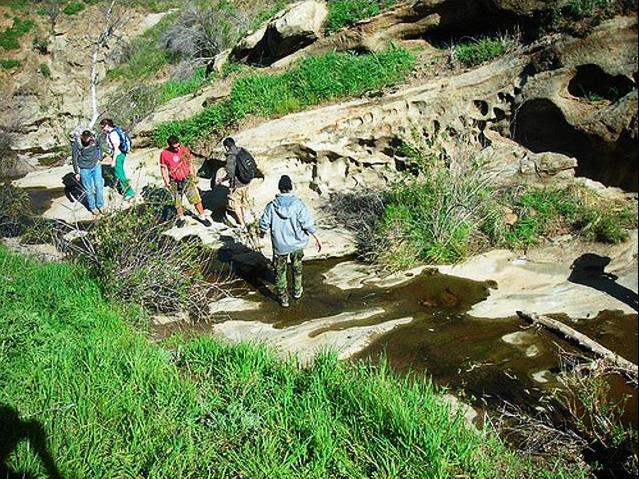
This EnviroReporter.com analysis supplements the exposé Brandeis-Bardin’s Toxic Denial. It compares two reports in order to see how many Brandeis-Bardin soil samples were found by the Department of Energy (DOE) to be over the background, or Background Threshold Value (BTV), of adjacent Area IV of the bordering Santa Susana Field Laboratory.
The DOE summary report was shared with American Jewish University (AJU) which gave it to the Jewish Journal in 2016. The weekly newspaper then published the report entitled Drainages from Area IV onto Brandeis Property Soil Data Summary – Soil Samples Exceeding DTSC Look-Up Table Values. Since AJU isn’t clear exactly when this summary was produced or by whom, it is assumed to be DOE and is referred to herein as “2016 DOE-AJU Summary Brandeis-Bardin Soils.”
EnviroReporter.com then compared DOE summary’s soil sampling results with the BTVs established for chemicals and radionuclides in adjoining Area IV. Those BTVs are the result of a $41.5 million EPA-funded study published in 2011 entitled SSFL Chemical Soil Background Study Chemical Analytes – Summary of BTV Results.
Determining the BTVs and amount of radiation contamination in Area IV and Northern Buffer Zone were part of the investigation conducted to implement the Administrative Orders on Consent (AOCs) that DOE and NASA signed with the state EPA’s Department of Toxic Substances Control. The AOCs empower the state to control the federal government’s order to clean up all contaminants to background levels.
DOE has agreed to remediate Area IV to each contaminant’s BTV. This one page DOE data summary yielded 21 Brandeis-Bardin soil samples which exceeded their respective Area IV background levels.
Mini-Glossary:
Area IV – Former nuclear research, reactors & radiation incineration site above Brandeis-Bardin
BTV – Background Threshold Value of toxic substance in Area IV of SSFL
DOE – Department of Energy
DTSC – Department of Toxic Substances Control
ER – EnviroReporter.com
PAH – Polycyclic Aromatic Hydrocarbons
ppb – parts per billion
ppm – parts per million
SSFL – Santa Susana Field Laboratory
Photographs by Danielle D.*
21 Brandeis-Bardin soil samples exceeded their respective Area IV BTVs
+++
ANTIMONY BTV: 0.738 MG/KG OR ppm
ANTIMONY Brandeis-Bardin (max): 2.22 ppm or 3.0 TIMES AREA IV BTV
[METAL – https://www.atsdr.cdc.gov/toxfaqs/tf.asp?id=331&tid=58:
“Exposure to antimony occurs in the workplace or from skin contact with soil at hazardous waste sites. Breathing high levels of antimony for a long time can irritate the eyes and lungs, and can cause problems with the lungs, heart, and stomach. This chemical has been found in at least 403 of 1,416 National Priorities List sites identified by the Environmental Protection Agency.”
“What is antimony?
Antimony is a silvery-white metal that is found in the earth’s crust. Antimony ores are mined and then mixed with other metals to form antimony alloys or combined with oxygen to form antimony oxide.
Little antimony is currently mined in the United States. It is brought into this country from other countries for processing. However, there are companies in the United States that produce antimony as a by-product of smelting lead and other metals.
Antimony isn’t used alone because it breaks easily, but when mixed into alloys, it is used in lead storage batteries, solder, sheet and pipe metal, bearings, castings, and pewter. Antimony oxide is added to textiles and plastics to prevent them from catching fire. It is also used in paints, ceramics, and fireworks, and as enamels for plastics, metal, and glass.”
w/
“In long-term studies, animals that breathed very low levels of antimony had eye irritation, hair loss, lung damage, and heart problems.”]
+++
NAPHTHALENE BTV: 2.39 ppb
NAPHTHALENE Brandeis-Bardin: 13 ppb or 5.4 TIMES AREA IV BTV
[PAH – https://www.atsdr.cdc.gov/toxfaqs/tf.asp?id=239&tid=43:
“Exposure to large amounts of naphthalene may damage or destroy some of your red blood cells. Naphthalene has caused cancer in animals.” & “Fuels such as petroleum and coal contain naphthalene… The major commercial use of naphthalene is in the manufacture of polyvinyl chloride (PVC) plastics.”]
w/
“Naphthalene can become weakly attached to soil or pass through soil into underground water.”
Polycyclic Aromatic Hydrocarbons (PAHs)
[https://www.atsdr.cdc.gov/phs/phs.asp?id=120&tid=25:
“In the environment, you are most likely to be exposed to PAH vapors or PAHs that are attached to dust and other particles in the air. Sources include cigarette smoke, vehicle exhausts, asphalt roads, coal, coal tar, wildfires, agricultural burning, residential wood burning, municipal and industrial waste incineration, and hazardous waste sites.”
“People living near waste sites containing PAHs may be exposed through contact with contaminated air, water, and soil.”
“Studies of people show that individuals exposed by breathing or skin contact for long periods to mixtures that contain PAHs and other compounds can also develop cancer.”]
+++
FLUORENE BTV: (drainage) 2.83 ppb
Fluorene Brandeis-Bardin: 16 ppb or 5.7 TIMES AREA IV BTV
[PAH – http://www.cdc.gov/niosh/idlh/7782414.html]
BIS(2-ETHYLHEXY)PHTHALATE BTV: 40.6 ppb
Bis(2-Ethylhexyl)phthalate Brandeis-Bardin: 64 ppb or 1.58 TIMES AREA IV BTV
[PAH – Also called DI(2-ETHYLHEXYL) PHTHALATE (http://www.cdc.gov/niosh/ipcsneng/neng0271.html) which leads to https://www.atsdr.cdc.gov/substances/toxsubstance.asp?toxid=65:
“Di(2-ethylhexyl)phthalate (DEHP)
Affected Organ Systems: Reproductive (Producing Children)
Cancer Classification: NTP: Reasonably Anticipated to be a Human Carcinogen
Chemical Classification: Phthalates
Summary: Di(2-ethylhexyl) phthlate (DEHP) is a manufactured chemical that is commonly added to plastics to make them flexible. DEHP is a colorless liquid with almost no odor. DEHP is present in plastic products such as wall coverings, tablecloths, floor tiles, furniture upholstery, shower curtains, garden hoses, swimming pool liners, rainwear, baby pants, dolls, some toys, shoes, automobile upholstery and tops, packaging film and sheets, sheathing for wire and cable, medical tubing, and blood storage bags.”]
ENDOSULFAN I BTV: 0.107 ppb
Endosulfan I Brandeis-Bardin: 0.92 ppb or 8.60 TIMES AREA IV BTV
[ENDOSULFAN I is an insecticide: https://www.atsdr.cdc.gov/toxfaqs/tf.asp?id=608&tid=113
“How might I be exposed to endosulfan?”
“Touching contaminated soil or fruits or plants that have been sprayed with endosulfan will result in a small amount entering the body through the skin.”
[ER – Endosulfan I wasn’t used on areas tested in ravines. It was used uphill at SSFL like the other chemicals and heavy metals here. Also, the reason there are BTVs for these toxic substances in the first place is because they occur enough in Area IV to warrant it.]
ENDRIN ALDEHYDE BTV: 0.547 ppb
Endrin Aldehyde Brandeis-Bardin: 0.98 ppb or 1.79 TIMES AREA IV BTV
[Pesticide: https://www.atsdr.cdc.gov/toxfaqs/tf.asp?id=616&tid=114
Highlights
Exposure to endrin can cause various harmful effects including death and severe central nervous system injury. Swallowing very large amounts of endrin may cause convulsions and kill you in a few minutes or hours. Exposure to high doses may result in headaches, dizziness, nervousness, confusion, nausea, vomiting, and convulsions. No long-term health effects have been noted in workers. Endrin has been found in at least 120 of the 1,430 National Priorities List sites identified by the Environmental Protection Agency (EPA).
What is endrin?
Endrin is a solid, white, almost odorless substance that was used as a pesticide to control insects, rodents, and birds. Endrin has not been produced or sold for general use in the United States since 1986.
&
“The persistence of endrin in the environment depends highly on local conditions. Some estimates indicate that endrin can stay in soil for over 10 years.” AND “You may be exposed to endrin in air, water, or soil if you live near a hazardous waste site.”]
+++
FLUORANTHENE BTV: Drainage 2.87 ppb
Fluoranthene Brandeis-Bardin: 6.9 ppb or 2.4 TIMES AREA IV BTV
[PAH – http://www.speclab.com/compound/c206440.htm:
“CONSTITUENT OF COAL TAR & PETROLEUM DERIVED ASPHALT USED AS LINING MATERIAL TO PROTECT INTERIOR OF STEEL & DUCTILE-IRON POTABLE WATER PIPES AND STORAGE TANKS RESEARCH CHEMICAL”]
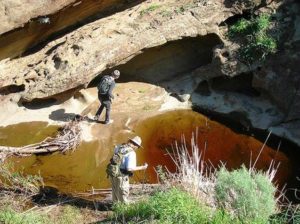
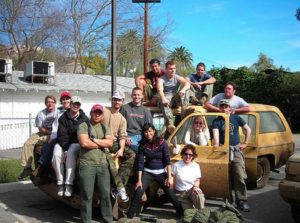
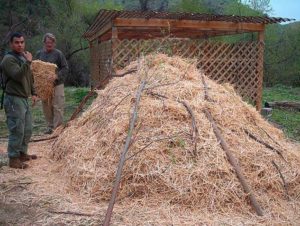
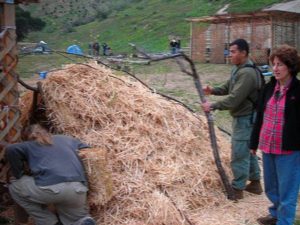
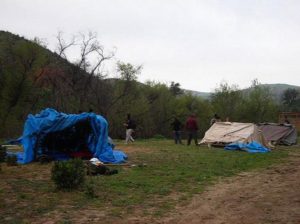
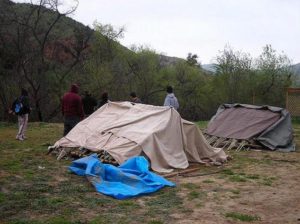
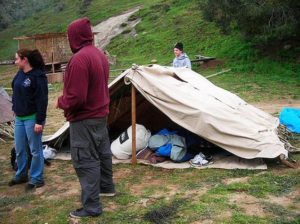












Recent Comments